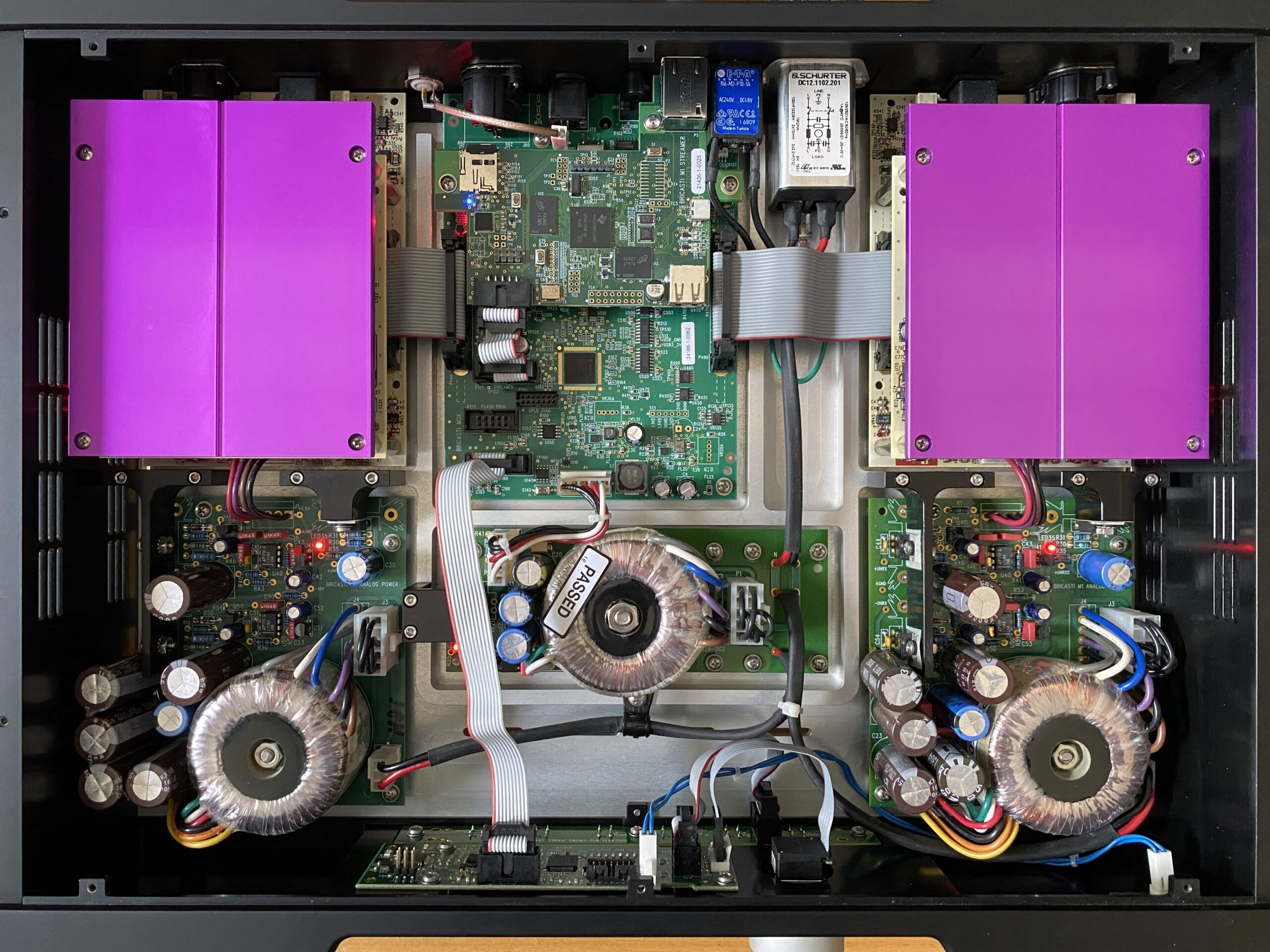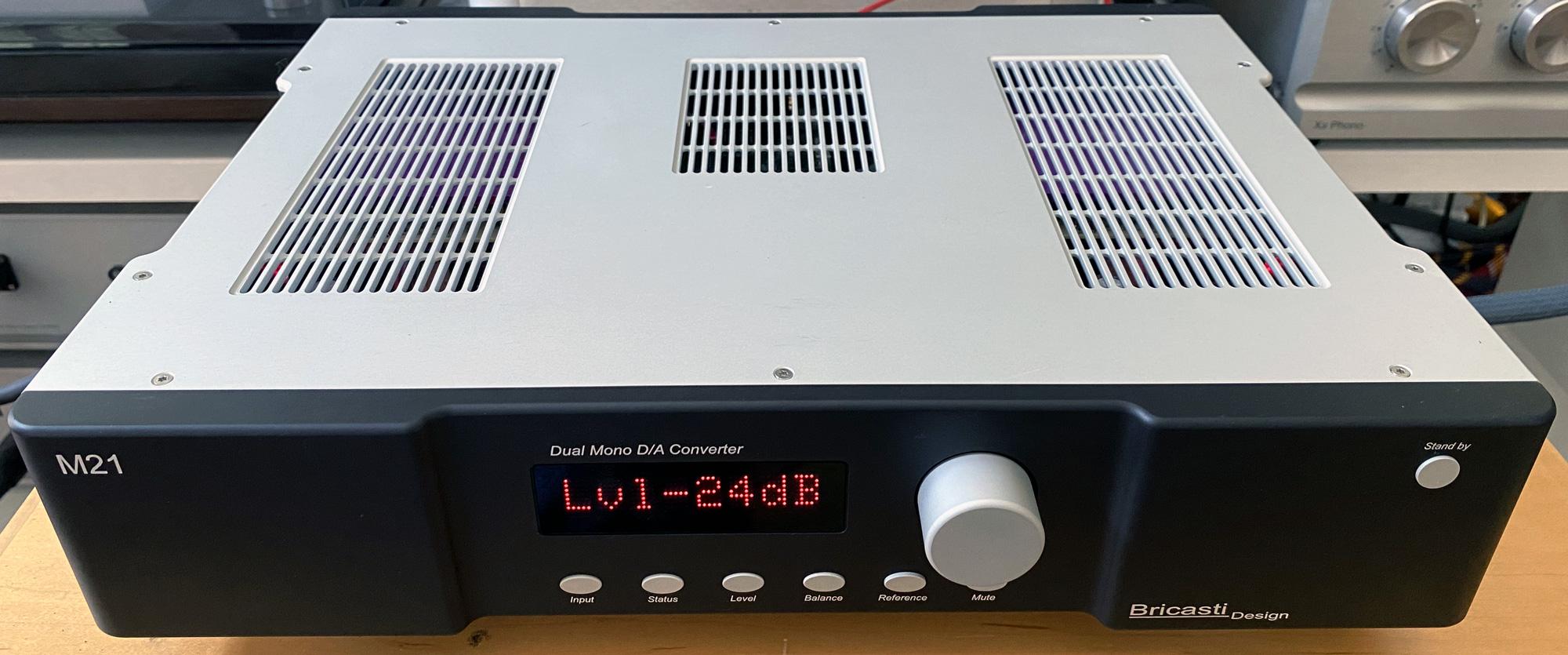Also read: Q&A – Bricasti Design M21 DAC.
Since reviewing the Audio Note UK Fifth Force/Fifth Element DAC system and the Esoteric K-01XD SACD player/USB DAC in Summer 2020, I have auditioned half a dozen more DACs ranging from sub-$1,000 to over $20,000. Many of them relied on the ESS Technology Sabre Pro chipsets but Audio Note UK, Esoteric and Bricasti Design are three companies standing apart with their own approach.
In 2015, Bricasti Design already had a first-rate digital-to-analog converter, the $8,999 M1, reviewed by senior reviewer Ed Momkus that year and it has been his reference to this day. It is bestowed with a tricked out dual-mono architecture and a very robust analog output stage that rivals preamplifiers costing just that much, all in a strikingly slim profile, which impressed me in my own auditioning as well.
Among the DACs sent my way since then, the very few that impressed were consistently the ones that packed in elaborate analog preamplification circuits and power supplies. The Audio Note UK Fifth Force/Fifth Element being a prime example with its elaborate outboard power supply. The Esoteric K-01XD is another, with its quad toroidal transformers and elaborate power regulating schemes. You can also include the Krell Universal Vanguard, the least costly in this camp. The Bricasti Design M21, the subject of this review, is the latest example of the group.
Not all amplification manufacturers are able to devote superior resources to DAC offerings, and not all that do so end up with a winning DAC design. For large corporations, final design decision-making comes from the top; for smaller enterprises, such as Bricasti Design, more focused, intensified designs and extensive measures seem to prevail more readily.
Company CEO Brian Zolner worked in Lexicon’s pro and consumer product sections from 1982, first as Sales Manager and then as Vice President of Sales before departing in 2002. Bricasti Design was formed two years later. The core of the BD engineering team is made up of ex-Madrigal people, who worked on many of the classic Mark Levinson products from two decades ago. In 2007, the company launched its first product, the M7 reverb unit, and it was for the professional market. 2010 saw the introduction of the first consumer product, the M1 dual-mono DAC. The M21 was launched in 2021.

M21 interior: Center board is main DSP, Inputs, control of Left and Right converter boards; Magenta top Left and Right houses DAC circuits. Both DSD and Ladder DAC circuits are on the top level, while Delta Sigma DAC occupies bottom level. Completely dual-mono. Toroidal transformers complete the amplification stage. Also dual-mono in configuration.
The M21 houses three DAC sections, as explained in the preceding Q&A article, namely the proprietary 1-bit DSD DAC, the Ladder DAC and the Delta Sigma DAC. And then the machine itself houses two completely isolated and fully differential channels with its own linear power supply, D/A converter, Direct Digital Synthesis (DDS) clocking and analog amplification. Its internal layout is such that it is photogenic and invites comparisons.
There are separate left and right boards to every section, including the Bricasti M1 Analog Power boards with toroidal transformers, the top Daughter “S” boards that carry the discrete 1-bit DSD DAC, the 18-bit Ladder DAC, and analog level control, the bottom Bricasti M12/21 Delta Sigma boards with its own Analog Devices 1955 24-bit DAC chipset and attendant DDS clocking circuit, the central top Bricasti M1 Streamer board and the MDX digital Input and processing board below it. Each board is endowed with its own power supply to feed its own section that serves to isolate itself from the processing system up- and down-stream. In addition, each of the four Daughter boards is governed by an Altera field programmable gate array processor. An Analog Devices dual-core Sharc DSP and Xlinx programmable logic device section on the Digital Input board controls the front panel display, general DSP operations, synchronization of the DDS clocking on each channel and a selection of Bricasti’s custom oversampling, anti-aliasing filters.
The construction of the M21 is of such caliber that the front panel, rear panel, top and bottom plates are all milled and CNC machined aluminum blocks. There is no bent sheet metal on the M21. Consequently, the aluminum blocks are milled and machined to exact tolerances for a precision fit. Finally, the panels are then anodized, and the markings laser etched to last for a long time.
Because of the need to house vastly more robust amplification circuitry and the trio of DAC sections, the M21 is thicker than the impossibly sexy and slim M1. Brian and Damon Gramont, marketing manager, recommend use of the DAC’s internal volume control in lieu of a third-party preamplifier, as the unit is capable of a +13.5 dBm and 3.5 dB RMS output at maximum.
The first and foremost on my audition list is the Native DSD (NDSD) section, and it connected to the Aurender N-1000SC caching music server via the now-defunct Light Harmonic Lightspeed USB cable. While the M21 also carries the functionality of a streamer via its ethernet port, the numerous application software for streaming could not display Japanese and Chinese titles and track information. Hence, this review will only discuss the use of the M21 as a DAC. Per Brian’s recommendation, the Bricasti flagship was in turn linked to the company’s own M28 solid-state monoblock amplifiers (I used a two-meter pair of Stage III Concepts Ckahron Ultimate Statement XLR cables). The monoblocks drove the 90 dB/8 Ohms sensitive Sound Lab Majestic 645 electrostatic panels. In this configuration, the M21 DAC’s volume control consistently hovered around 15dB attenuation when driving the company’s own M28 monoblock amplifiers directly, which were set to zero input attenuation. According to Brian, a 0dB volume setting on the M21 means a “hard bypass” of the attenuator. He therefore recommended reducing the adjustable input gain on the M28 monoblocks so as to achieve near zero attenuation of the M21’s output. Speaking for myself, having auditioned the M28 in various input levels, I prefer having at least one device, namely the M28 monoblocks in this case, at the zero-attenuation setting.
The Bricasti Design M21 flagship DAC was placed atop the Pass Laboratories Xs Preamp on a trio of Combak Harmonix TU-66ZX footers for easy access to the S/PDIF, Toslink, USB and LAN connections on the rear chassis. The dandy little remote, the prettiest I’ve seen, features a polished chrome skin and a rather hefty weight despite its small size. All functions were accessible either through the remote or on the DAC’s front panel, including Clock/Fine or Wide, Phase, Input with sampling rate, display brightness, etc. Methinks it could use a larger display with more comprehensive presentation of statuses, but then again that would intrude upon the harmony of the physique.
- (Page 1 of 3)
- Next page →





